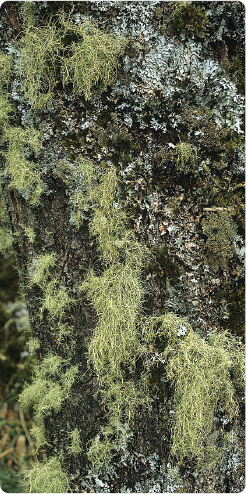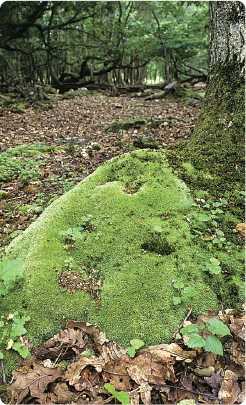
From a climatic perspective, trees help moderate temperature extremes and increase humidity within woodland. Unsurprisingly, this has a beneficial effect upon mosses, liverworts and lichens, many of which are prone to desiccation. Native woodland floors are often carpeted with these primitive plants, and fallen logs and rotting timber are soon cloaked in their fresh green growth.
In addition to their climatic effect, trees have the added benefit, ecologically, of creating a third dimension in any woodland. Bryophytes take full advantage of this added woodland complexity and, under certain circumstances, trunks and branches can be festooned with a lush growth of mosses, liverworts and lichens. When growing in such places, these plants are referred to as epiphytes – they grow on the surface of the tree, are not parasitic, and cause no damage to the host.

In western Britain, where annual rainfall is high, tree trunks are often completely cloaked in mosses and liverworts.

White Fork Moss Leucobryum glaucum forms sizeable clumps on undisturbed woodland floors, particularly under Beech.
Visit almost any native woodland in Britain and you will find a profusion of mosses, liverworts and lichens growing both on the woodland floor and as epiphytes. However, for truly spectacular displays of epiphytic bryophytes you will need to visit woodlands in the west of the country, particularly those that grow on west-facing, rain-soaked hills or on the coast. In places it can be almost impossible to discern bare bark, with trunks, branches and twigs simply dripping with epiphytes. They cause no harm to the trees, other than the added weight perhaps, and gain their nutrition from nutrient run-off and from rain. Of course, the same is true of that other familiar epiphyte Ivy (a flowering plant), which is often maligned but hugely important in wildlife terms.